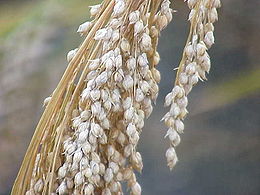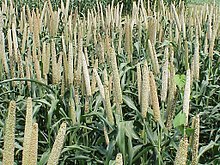Gero
|
|
Wannan mukalar bata da Reference (Manazarta) ko daya, ka taimaka ta hanyar samar da Manazarta daga littafi ko yanar gizo, duba wannan shafin domin samun masaniya akan yanda zaka samar da Reference (Manazarta) a cikin wannan mukalar.
|
| Gero | |
|---|---|
| siril da hatsi | |
 |



Gero[1][2] nau’i ne na ciyawa wanda ake nomawa domin, samun abinci. Gero na daga cikin dangin hatsi[3] waɗan da a Turance ake kira da "grains". Kayan amfanin gona ne da ake nomawa sama da shekaru dubu biyar (5000) a duniya. Gero, nau’in tsiro ne mai matuƙar juriya.Yana jure wa fari, dalilin da ya sa har a sahara ma ana iya shuka shi. Guri ɗaya kawai da a gargajiyance da kuma.
Tarihi
[gyara sashe | gyara masomin]Wasu manazarta suna ganin gero fa jar fata ne da ya fito daga yankin Asiya. Microsoft Encarta sun ruwaito cewa ana kuma noma gero a yankin Asiya[4] sama da shekaru dubu biyar, nahiyar da ake yi wa kallon cewa daga can ya samo asali.[Ana bukatan hujja].
Noma
[gyara sashe | gyara masomin]Gero, kayan amfanin gona ne mai juriya.[Ana bukatan hujja] Yana iya jure wa fari sannan kuma yana iya tsirowa a ƙasar da bata da ƙarfi sosai. Ana kuma shuka shi sannan kuma a girbe shi a tsawon kwanaki sittin zuwa tamanin. Ana noma shi a ƙasashen duniya daban-daban irinsu Indiya, Najeriya[5], Nijar, Ghana, Mali, Burkina Faso, Sudan, Habasha (Ethiopia), Cadi, Senegal, Rasha da dai sauransu. Duk da cewa, Indiya ce ta fi kowace ƙasa noma gero a duniya. Ƙasashe irin su China (Sin), India, Najeriya, Nijar, Asiya ta tsakiya da Asiya ta Yamma, Afirka ta Yamma, ƙasashen rusasshiyar Tarayyar Sobiyet da sauransu domin abinci suke noma gero. A ƙasar Amurka kuma da Yammacin Turai, ana noma shi ne a matsayin abincin kaji, tsuntsaye da kuma dabbobi.[Ana bukatan hujja]
Sinadarai
[gyara sashe | gyara masomin]Gero yana ɗauke da sinadaran abinci da dama. Duk rabin kofi ɗaya na gero mai nauyin giram 100 yana ɗauke da:[Ana bukatan hujja]
1. Giram 10.6 na furotin.
2. Giram 17.3 na ruwa.
3. Giram 1.3 na faiba.
4. Giram 5.0 na maiƙo.
5. Giram 8 na bitamin .
6. Giram 2.3 na minaral.
7. Milgiram 8 na ayon.
8. Milgiram 38 na kalsiyom.
9. Giram 67 na Kabohaidiret, wanda shine muhimmin sinadarin da yake ɗauke da shi.
10. Yana ɗauke da adadin kaloris 380.
Amfani
[gyara sashe | gyara masomin]a kiwon lafiya
[gyara sashe | gyara masomin]Ga kaɗan daga cikin ɗimbin alfanu da gero yake da su a fannin kiwon lafiya:[Ana bukatan hujja]
1. Maganin cutar Siga ta hanyar saukar da sinadarin sikarin da ke cikin jini. saboda yana sinadarin faiba da yake ɗauke da shi wanda shi ke da alhakin sarrafa sinadarin Sugar da ke cikin jini.
2. Maganin gyambon ciki.
3. Inganta lafiyar zuciya saboda sinadarin maganiziyom da yake ɗauke da shi. Wanda kuma sinadari ne da bincike ya tabbatar da cewa yana rage ƙarfin tarin fuka (Asthma).
4. Yana saukar da hawan jini tare kuma da rage barazanar kamuwa da cutar bugun zuciya saboda sinadaran maganiziyom da kalsiyom da yake ɗauke da su.
5. Yana rage yawan sinadarin kwalastero. Saboda yana ɗauke da sinadarin Niyasin (Niacin) wanda shi ne sinadarin bitamin B3 (Vitamin B3).
6. Narkar da tsakuwar ƙoda: Sinadarin faiba da ke cikin gero, yana taimakawa wajen narkar da tsakuwar ƙoda.
7. Ƙara girman ƙashi da haɓɓakarsa: Yana ɗauke da sinadarin fosforos (Phosphorous) wanda ke taimaka wa ƙashi wajen girma da haɓɓaka sannan kuma ya gyara shi idan ya samu lalura.
8. Gudawa: Gero yana hana gudawa saboda sinadarin laktik asid (Lactic acid) da yake ɗauke da shi. Wannan sinadari kuma shi ne bakteriya.
9. Tallafa wa garkuwan jiki: Gero yana ɗauke da sinadaran da suke saka shi yake zama garkuwa ga jiki.
10. Kansa: Gero yana bayar da kariya daga kamuwa da cutar kansar mama. Saboda yana ɗauke da sinadaran finolik asid (Phenolic acids), tanin (Tannins) da kuma fitet (Phytate) sinadaran da suke samar da sinadaran da ke yaƙar ƙwayoyin cutar da suke haddasa kansar mama.
11. Kariya daga lalacewar tsokar jiki da kuma saurin warkar da rauni (Kamar yankewa ko tujewar fatar jiki). Saboda yana ɗauke da sinadarin ferulik asid (Ferulic acid).
12. Yana ɗumama yanayin jiki a lokutan sanyi da na damina.
Sarrafa abinci
[gyara sashe | gyara masomin]Muhimmai daga cikin nu’aukan abincin gargajiya da ake yi a Ƙasar Hausa da gero sun haɗa da:[Ana bukatan hujja]
1. Tuwon Biski.
2. Dambu.
3. Fate ko Fate-fate.
4. Tuwon Laushi.
5. Kunun Tsamiya .
6. Kunun Gyaɗa.
7. Kunun Kanwa.
8. Koko.
9. Waina ko Masa.
10. Fura.
11. Gumba.
Hotuna
[gyara sashe | gyara masomin]-
Wani mutum rike da gero
-
Jacques Le Moyne de Morgues. Millet
-
A Parrot in a Millet plant-
-
Gero dan nahiyar Afirka
-
Grain millet
Manazarta
[gyara sashe | gyara masomin]- ↑ "Definition of millet". Oxford Dictionaries. Oxford University. Retrieved 21 July 2017.
- ↑ https://www.google.com/url?sa=t&source=web&rct=j&opi=89978449&url=https://www.foodbev.com/news/millet-the-millennia-old-grain-of-the-future&ved=2ahUKEwim3v7nwveGAxVSZ0EAHZrNDvkQxfQBKAB6BAgLEAI&usg=AOvVaw0BVHkEuUeLSfVjJdNuSutA
- ↑ https://www.google.com/url?sa=t&source=web&rct=j&opi=89978449&url=https://hausa.legit.ng/news/1578955-tsadar-rayuwa-yan-kasuwar-hatsi-a-kano-sun-karya-farashin-kayan-abinci-don-saukakawa-jamaa/&ved=2ahUKEwiZrMnKwfeGAxXeQkEAHZSTCRcQxfQBKAB6BAgPEAI&usg=AOvVaw00ZVZ9GA1KIs8g6ggOx5-V
- ↑ https://www.google.com/url?sa=t&source=web&rct=j&opi=89978449&url=https://www.usip.org/publications/2024/06/us-china-rivalry-asia-and-africa-lessons-cold-war&ved=2ahUKEwiVwrWAwveGAxVQRkEAHQPmAbEQxfQBKAB6BAgPEAI&usg=AOvVaw0dPKdmos1A5kmzoG_Kej7A
- ↑ https://www.google.com/url?sa=t&source=web&rct=j&opi=89978449&url=https://hausa.leadership.ng/nijeriya-na-fuskantar-koma-baya-a-noman-alkama-masara-da-gero-rahoto/&ved=2ahUKEwjS3YCmwveGAxXiYEEAHSfsB9EQxfQBKAB6BAgHEAI&usg=AOvVaw0RhtJJjXcjBFaKfJqSeb4N





